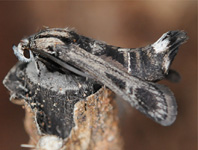Abstract
Species of Apelaunothrips are fungus-feeders on dead leaves, particularly in leaf-litter, and they are recorded across the Old World tropics from Africa to northern Australia and southern Japan. All species in this genus have the maxillary stylets 4–6 microns in diameter, considerably broader than the 2–3 micron diameter that is typical among Phlaeothripinae. The species are largely uniform in structure, but in four species the larger males have fore femora enlarged with a conspicuous tubercle on the inner margin at the base. In one of these species, the males are dimorphic, with no intermediates between large and small individuals, in contrast to the continuous variation in structure found in many polymorphic Phlaeothripidae. A key is provided to the 37 recognised species of Apelaunothrips, including the following: A. desleyae sp.n. from northern Australia; A. bogor sp.n. from Java; A. gombak sp.n. from Peninsular Malaysia.

